DeWalt DW929 Handleiding
DeWalt
Boormachine
DW929
Bekijk gratis de handleiding van DeWalt DW929 (7 pagina’s), behorend tot de categorie Boormachine. Deze gids werd als nuttig beoordeeld door 11 mensen en kreeg gemiddeld 4.7 sterren uit 6 reviews. Heb je een vraag over DeWalt DW929 of wil je andere gebruikers van dit product iets vragen? Stel een vraag
Pagina 1/7

INSTRUCTION MANUAL
GUIDE D'UTILISATION
MANUAL DE INSTRUCCIONES
INSTRUCTIVO DE OPERACIÓN, CENTROS DE SERVICIO Y PÓLIZA
DE GARANTÍA. ADVERTENCIA: LÉASE ESTE INSTRUCTIVO ANTES
DE USAR EL PRODUCTO.
DEWALT Industrial Tool Co., 701 East Joppa Road, Baltimore, MD 21286
(APR08) Part No. N008775 Copyright © 2002, 2003, 2006, 2008 DEWALT
The following are trademarks for one or more D WALT power tools: the yellow and black color scheme; theE
“D” shaped air intake grill; the array of pyramids on the handgrip; the kit box configuration; and the array of
lozenge-shaped humps on the surface of the tool.
DW927, DW928, DW929, DW959 (Type/Tipo 1, Type/Tipo 2)
Cordless Adjustable Clutch Driver/Drill
Perceuse-tournevis sans fil à embrayage réglable
Taladro/destornillador inalámbrico con embrague ajustable
If you have questions or comments, contact us.
Pour toute question ou tout commentaire nous contacter, .
Si tiene dudas o comentarios, contáctenos.
1-800-4-DEWALT • www.dewalt.com
IF YOU HAVE ANY QUESTIONS OR COMMENTS ABOUT THIS OR ANY DEWALT TOOL,
CALL US TOLL FREE AT: 1-800-4-D WALT (1-800-433-9258) E
General Safety Rules – For All Battery Operated Tools
WARNING! Read and understand all instructions. Failure to follow all instructions listed
below may result in electric shock, fire and/or serious personal injury.
SAVE THESE INSTRUCTIONS
WORK AREA
•Keep your work area clean and well lit. Cluttered benches and dark areas invite accidents.
•Do not operate power tools in explosive atmospheres, such as in the presence of
flammable liquids, gases, or dust. Power tools create sparks which may ignite the dust or
fumes.
•Keep bystanders, children, and visitors away while operating a power tool. Distractions
can cause you to lose control.
ELECTRICAL SAFETY
•Do not abuse the cord. Never use the cord to carry the tool. Keep cord away from heat,
oil, sharp edges or moving parts. Replace damaged cords immediately. Damaged cords
may create a fire.
•A battery operated tool with integral batteries or a separate battery pack must be
recharged only with the specified charger for the battery. A charger that may be suitable
for one type of battery may create a risk of fire when used with another battery.
•Use y batter operated tool only with the specifically designated battery pack. Use of any
other batteries may create a risk of fire.
PERSONAL SAFETY
•Stay alert, watch what you are doing and use common sense when operating a power
tool. Do not use tool while tired or under the influence of drugs, alcohol, or medication.
A moment of inattention while operating power tools may result in serious personal injury,
•Dress properly. Do not wear loose clothing or jewelry. Contain long hair. Keep your hair,
clothing, and gloves away from moving parts.Loose clothing, jewelry, or long hair can be
caught in moving parts. Air vents often cover moving parts and should also be avoided.
•Avoid accidental starting. Be sure switch is in the locked or off position before inserting
battery pack. Carrying tools with your finger on the switch or inserting the battery pack into a
tool with the switch on invites accidents.
•Remove adjusting keys or wrenches before turning the tool on. A wrench or a key that is
left attached to a rotating part of the tool may result in personal injury.
•Do not overreach. Keep proper footing and balance at all times. Proper footing and
balance enables better control of the tool in unexpected situations.
•Use safety equipment. Always wear eye protection. Dust mask, non-skid safety shoes,
hard hat, or hearing protection must be used for appropriate conditions.
TOOL USE AND CARE
•Use clamps or other practical way to secure and support the workpiece to a stable
platform. Holding the work by hand or against your body is unstable and may lead to a loss
of control.
•Do not force tool. Use the correct tool for your application. The correct tool will do the job
better and safer at the rate for which it is designed.
•Do not use tool if switch does not turn it on or off. A tool that cannot be controlled with the
switch is dangerous and must be repaired.
•Disconnect battery pack from tool or place the switch in the locked or off position
before making any adjustments, changing accessories, or storing the tool. Such
preventative safety measures reduce the risk of starting the tool accidentally.
•Store idle tools out of reach of children and other untrained persons. Tools are
dangerous in the hands of untrained users.
•When battery pack is not in use, keep it away from other metal objects like: paper clips,
coins,keys, nails,screws,or other small metal objects that can make a connection from
one terminal to another. Shor ting the battery terminals together may cause sparks, burns,
or a fire.
•Maintain tools with care. Keep cutting tools sharp and clean. Properly maintained tools,
with sharp cutting edges are less likely to bind and are easier to control.
•Check for misalignment or binding of moving parts, breakage of parts, and any other
condition that may affect the tool’s operation. If damaged, have the tool serviced before
using. Many accidents are caused by poorly maintained tools.
•Use only accessories that are recommended by the manufacturer for your model.
Accessories that may be suitable for one tool, may create a risk of injury when used on another
tool.
SERVICE
•Tool service must be performed only by qualified repair personnel. Service or
maintenance performed by unqualified personnel may result in a risk of injury.
•When servicing a tool, use only identical replacement parts. Follow instructions in the
Maintenance section of this manual. Use of unauthorized parts or failure to follow
Maintenance Instructions may create a risk of shock or injury.
Additional Safety Rules
•Hold tool by insulated gripping surfaces when performing an operation where the tool
may contact hidden wiring. Contact with a “live” wire will also make exposed metal parts of
the tool “live” and shock the operator.
CAUTION: When not in use, place tool on its side on a stable surface where it will not
cause a tripping or falling hazard. Some tools with large battery packs will stand upright on
the battery pack but may be easily knocked over.
WARNING: Some dust created by power sanding, sawing, grinding, drilling, and other con-
struction activities contains chemicals known to cause cancer, birth defects or other reproduc-
tive harm. Some examples of these chemicals are:
• lead from lead-based paints,
• crystalline silica from bricks and cement and other masonry products, and
• arsenic and chromium from chemically-treated lumber (CCA).
Your risk from these exposures varies, depending on how often you do this type of work.To reduce
your exposure to these chemicals: work in a well ventilated area, and work with approved safety
equipment, such as those dust masks that are specially designed to filter out microscopic
particles.
•Avoid prolonged contact with dust from power sanding, sawing, grinding, drilling, and
other construction activities. Wear protective clothing and wash exposed areas with
soap and water. Allowing dust to get into your mouth, eyes, or lay on the skin may promote
absorption of harmful chemicals.
• The label on your tool may include the following symbols. The symbols and their definitions are
as follows:
V ..................volts A ....................amperes
Hz ................hertz W ....................watts
min ..............minutes ..................alternating current
............direct current no....................no load speed
................Class I Construction ....................earthing terminal
....................(grounded) ....................safety alert symbol
..................Class II Construction …/min ............revolutions or reciprocation
.................... ........................(double insulated) per minute
BPM ............beats per minute
Important Safety Instructions for Battery Packs
Your tool uses a 12.0 volt, 14.4 volt, or an 18 volt D WALT battery Pack. When orderingE
replacement battery packs, be sure to include catalog number and voltage. Extended Run-Time
battery packs deliver more run-time than standard battery packs. Consult the chart at the end
of this manual for compatibility of chargers and battery packs.
NOTE: Your tool will accept either standard or Extended Run Time battery packs. However, be
sure to select proper voltage. Batteries slowly lose their charge when they are not on the
charger, the best place to keep your battery is on the charger at all times.
The battery pack is not fully charged out of the carton. Before using the battery pack and
charger, read the safety instructions below. Then follow charging procedures outlined.
READ ALL INSTRUCTIONS
•Do not incinerate the battery pack even if it is severely damaged or is completely worn
out. The battery pack can explode in a fire.
•A small leakage of liquid from the battery pack cells may occur under extreme usage
or temperature conditions. This does not indicate a failure.
However, if the outer seal is broken:
a. and the battery liquid gets on your skin, immediately wash with soap and water for
several minutes.
b. and the battery liquid gets into your eyes, flush them with clean water for a minimum of
10 minutes and seek immediate medical attention. (Medical note: The liquid is 25-35%
solution of potassium hydroxide.)
• Charge the battery packs only in DEWALT chargers.
•DO NOT splash or immerse in water or other liquids.
• Do not store or use the tool and battery pack in locations where the temperature may
reach or exceed 105°F (40˚) (such as outside sheds or metal buildings in summer).
DANGER: Electrocution hazard. Never attempt to open the battery pack for any reason. If
battery pack case is cracked or damaged, do not insert into charger. Electric shock or
electrocution may result. Damaged battery packs should be returned to service center for
recycling.
NOTE: Battery storage and carrying caps are provided for use whenever the battery
is out of the tool or charger. Remove cap before placing battery in charger or tool.
WARNING: Fire hazard. Do not store or carry battery so that metal objects
can contact exposed battery terminals. For example, do not place battery in
aprons, pockets, tool boxes, product kit boxes, drawers, etc., with loose nails, screws,
keys, etc. without battery cap. Transporting batteries can possibly cause fires if
the battery terminals inadvertently come in contact with conductive materials such as
keys, coins,hand tools and the like. The US Department of Transportation Hazardous Material
Regulations (HMR) actually prohibit transporting batteries in commerce or on airplanes (i.e.,
packed in suitcases and carr y-on luggage) UNLESS they are properly protected from short
circuits. So when transporting individual batteries, make sure that the battery terminals are
protected and well insulated from materials that could contact them and cause a short circuit.
CAUTION: Battery pack must be securely attached to tool. If battery pack is detached,
personal injury may result.
The RBRC™ Seal
The RBRC™ (Rechargeable Battery Recycling Corporation) Seal on the nickel
cadmium and nickel metal hydride batteries (or battery packs) indicate that the costs
to recycle these batteries (or battery packs) at the end of their useful life have already
been paid by DEWALT. In some areas, it is illegal to place spent nickel
cadmium and nickel metal hydride batteries in the trash or municipal solid waste
stream and the RBRC program provides an environmentally conscious alternative.
RBRC™ in cooperation with DEWALT and other battery users, has established programs in the
United States and Canada to facilitate the collection of spent nickel cadmium and nickel metal
hydride batteries. Help protect our environment and conserve natural resources by returning the
spent nickel cadmium and nickel metal hydride batteries to an authorized DEWALT service center
or to your local retailer for recycling. You may also contact your local recycling center for
information on where to drop off the spent battery.
RBRC™ is a registered trademark of the Rechargeable Battery Recycling Corporation.
Important Safety Instructions for Batter Chargersy
SAVE THESE INSTRUCTIONS: This manual contains important safety instructions for battery
chargers.
• Before using charger, read all instructions and cautionary markings on charger, battery pack,
and product using battery pack.
DANGER: Electrocution hazard. 120 volts are present at charging terminals. Do not probe with
conductiv objectse .
WARNING: Shock hazard. Do not allow any liquid to get inside charger.
CAUTION: Burn hazard. To reduce the risk of injury, charge only DEWALT rechargeable
batteries. Other types of batteries may burst causing personal injury and damage.
CAUTION: Under certain conditions, with the charger plugged in to the power supply, the
exposed charging contacts inside the charger can be shorted by foreign material. Foreign
materials of a conductive nature such as, but not limited to, steel wool, aluminum foil, or any
buildup of metallic particles should be kept away from charger cavities. Always unplug the charger
from the power supply when there is no battery pack in the cavity. Unplug charger before
attempting to clean.
•DO NOT attempt to charge the battery pack with any chargers other than the ones in
this manual. The charger and battery pack are specifically designed to work together.
•These chargers are not intended for any uses other than charging DEWALT
rechargeable batteries. Any other uses may result in risk of fire, electric shock or
electrocution.
•Do not expose charger to rain or snow.
•Pull by plug rather than cord when disconnecting charger. This will reduce risk of damage
to electric plug and cord.
•Make sure that cord is located so that it will not be stepped on, tripped over, or
otherwise subjected to damage or stress.
•Do not use an extension cord unless it is absolutely necessary. Use of improper extension
cord could result in risk of fire, electric shock, or electrocution.
•An extension cord must have adequate wire size (AWG or American Wire Gauge) for
safety. The smaller the gauge number of the wire, the greater the capacity of the cable, that
is 16 gauge has more capacity than 18 gauge. When using more than one extension to make
up the total length, be sure each individual extension contains at least the minimum wire size.
Recommended Minimum Wire Size for Extension Cords
Total Length of Cord
25 ft. 50 ft. 75 ft. 100 ft. 125 ft. 150 ft. 175 ft.
7.6 m 15.2 m 22.9 m 30.5 m 38.1 m 45.7 m 53.3 m
Wire Size AWG
18 18 16 16 14 14 12
•Do not place any object on top of charger or place the charger on a soft surface that
might block the ventilation slots and result in excessive internal heat.Place the charger
in a position away from any heat source. The charger is ventilated through slots in the top and
the bottom of the housing.
•Do not operate charger with damaged cord or plug — have them replaced immediately.
•Do not operate charger if it has received a sharp blow, been dropped, or otherwise
damaged in any way. Take it to an authorized service center.
•Do not disassemble charger; take it to an authorized service center when service or
repair is required. Incorrect reassembly may result in a risk of electric shock, electrocution or
fire.
•Disconnect the charger from the outlet before attempting any cleaning.This will reduce
the risk of electric shock. Removing the battery pack will not reduce this risk.
•NEVER attempt to connect 2 chargers together.
•The charger is designed to operate on standard household electrical power (120 Volts).
Do not attempt to use it on any other voltage. This does not apply to the vehicular charger.
Using Automatic Tune-Up™ Mode
The Automatic Tune-Up™ Mode equalizes or balances the individual cells in the battery pack
allowing it to function at peak capacity. Battery packs should be tuned up weekly or after 10
charge/discharge cycles or whenever the pack no longer delivers the same amount of work. To
use the Automatic Tune-Up™, place the battery pack in the charger and leave it for at least 8
hours. The charger will cycle through the following modes.
1. The red light will blink continuously indicating that the 1-hour charge cycle has started.
2. When the 1-hour charge cycle is complete, the light will stay on continuously and will no longer
blink. This indicates that the pack is fully charged and can be used at this time.
3. Whenever the pack is left in the charger after the initial 1-hour charge, the charger will begin
the Automatic Tune-Up™ Mode.This mode continues up to 8 hours or until the individual cells

Chucks
WARNING: ALWAYS Burn Hazard. wear gloves when changing bits. Accessible metal parts
on the tool and bits may get extremely hot during operation. Small bits of broken material may
damage bare hands.
WARNING: Do not attempt to tighten drill bits (or any other accessory) by gripping the front
part of the chuck and turning the tool on. Damage to the chuck and personal injury may result.
Always lock off trigger switch when changing accessories.
KEYLESS DOUBLE SLEEVE CHUCK (FIG. 7)
(DW927, DW928, DW959–Type 1)
Your tool features a keyless chuck for greater convenience.To insert a drill bit or other accessory,
follow the steps listed below.
1. Lock the trigger in the OFF position as previously described.
2. Grasp the rear half of the chuck with one hand and use your other hand to rotate the front
half counterclockwise, as shown. Rotate far enough so that the chuck opens sufficiently to
accept the desired accessory.
3. Insert the bit or other accessory about 3/4" (19 mm) the chuck and tighten securely by holding
the rear half of the chuck and rotating the front portion in the clockwise direction.
To release the accessory, repeat steps 1 and 2 listed above.
KEYLESS SINGLE SLEEVE CHUCK (FIG. 8)
(DW959–Type 2)
Your tool features a keyless chuck with one rotating sleeve for one-handed operation of the
chuck. To insert a drill bit or other accessory, follow these steps.
1. Lock the trigger in the OFF position as previously described.
2. Grasp the black sleeve of the chuck with one hand and use the other hand to secure the
tool. Rotate the sleeve counterclockwise far enough to accept the desired accessory.
3. Insert the accessory about 3/4" (19 mm) into the chuck and tighten securely byrotating the
chuc sleek ve clockwise with one hand while holding the tool with the other. Your tool is
equipped with an automatic spindle lock mechanism.This allows you to open and close the
chuck with one hand.
To release the accessory, repeat steps 1 and 2 listed above.
Be sure to tighten chuck with one hand on the chuck sleeve and one hand holding the tool for
maximum tightness.
Operation as a Drill
Turn the collar to the drill bit symbol. Install and tighten the desired drill bit in the chuck. Select
the desired speed/torque range using the dual range gear shifter to match the speed and torque
to the planned operation. Follow these instructions for best results when drilling.
DRILLING
1. Use sharp drill bits only. For WOOD, use twist drill bits, spade bits, power auger bits, or hole
saws. For METAL, use high speed steel twist drill bits or hole saws. For MASONRY, such as
brick, cement, cinder block, etc., use carbide-tipped bits.
2. Be sure the material to be drilled is anchored or clamped firmly. If drilling thin material, use a
“back-up” block to prevent damage to the material.
3. Always apply pressure in a straight line with the bit. Use enough pressure to keep the drill bit
biting, but do not push hard enough to stall the motor or deflect the bit.
4. Hold tool firmly to control the twisting action of the drill.
5. IF DRILL STALLS, it is usually because it is being overloaded. RELEASE TRIGGER
IMMEDIATELY, remove drill bit from work, and determine cause of stalling.DO NOT CLICK
TRIGGER OFF AND ON IN AN ATTEMPT TO START A STALLED DRILL – THIS CAN
DAMAGE THE DRILL.
6. To minimize stalling upon breaking through the material, reduce pressure on drill and ease
the bit through the last fractional part of the hole.
7. Keep the motor running when pulling the bit back out of a drilled hole. This will help prevent
jamming.
8. With variable speed drills there is no need to center punch the point to be drilled. Use a slow
speed to start the hole and accelerate by squeezing the trigger harder when the hole is deep
enough to drill without the bit skipping out. Operate at full-on after starting the bit.
DRILLING IN WOOD
Holes in wood can be made with the same twist drills used for metal. These bits may overheat
unless pulled out frequently to clear chips from the flutes. For larger holes, use low speed wood
bits. Work that is likely to splinter should be backed up with a block of wood.
DRILLING IN METALS
Use a cutting lubricant when drilling metals.The exceptions are cast iron and brass which should
be drilled dry. The cutting lubricants that work best are sulphurized cutting oil or lard oil; bacon
grease will also serve the purpose.
DRILLING MASONRY
Use carbide tipped masonry bits at low speeds. Keep even force on the drill but not so much that
you crack the brittle materials. A smooth, even flow of dust indicates the proper drilling rate.
Operation as a Screwdriver
Select the desired speed/torque range using the dual range gear shifter on the top of tool to
match the speed and torque to the planned operation.
Insert the desired fastener accessory into the chuck as you would any drill bit.Make a few practice
runs in scrap or unseen areas to determine the proper position of the clutch collar.
MAXIMUM RECOMMENDED CAPACITIES
DW927, DW928, DW929 DW959
WOOD 1-1/2" (38 mm) 1-1/2" (38 mm)
STEEL 3/8" (10 mm) 1/2" (13 mm)
CONCRETE 3/16" (4.8 mm) 1/4" (6.4 mm)
MAINTENANCE
WARNING: To reduce the risk of serious personal injury, turn tool off and disconnect
tool from power source before making any adjustments or removing/installing
attachments or accessories.
Cleaning
WARNING: Blow dirt and dust out of all air vents with dry air at least once a week.Wear safety
glasses when performing this. Never use solvents or other harsh chemicals for cleaning the non-
metallic parts of the tool. These chemicals may weaken the plastic materials used in these parts.
Use a cloth dampened only with water and mild soap. Do not use gasoline, turpentine, lacquer
or paint thinner, dry cleaning fluids or similar products. Never let any liquid get inside the tool;
never immerse any part of the tool into a liquid.
CHARGER CLEANING INSTRUCTIONS
WARNING: Shock hazard. Disconnect the charger from the AC outlet before cleaning. Dirt and
grease may be removed from the exterior of the charger using a cloth or soft non-metallic brush.
Do not use water or any cleaning solutions.
Accessories
WARNING: Since accessories, other than those offered by D WALT have not been tested withE
this product, use of such accessories with this tool could be hazardous. To reduce the risk of
injury, only DEWALT, recommended accessories should be used with this product.
in the battery pack are equalized.The battery pack is ready for use and can be removed at any
time during the Tune-Up™ Mode.
4. Once the Automatic Tune-Up™ Mode is complete the charger will transition to a maintenance
charge; the indicator light shuts off when the Automatic Tune-Up™ Mode is complete.
SAVE THESE INSTRUCTIONS FOR FUTURE USE
Chargers
Your battery can be charged in D WALT 1 Hour Chargers, 15 Minute Chargers or Vehicular E
12 Volt Charger. Be sure to read all safety instructions before using your charger. Consult the chart
at the end of this manual for compatibility of chargers and battery packs.
Charging Procedure
DANGER: Electrocution hazard. 120 volts are present at charging terminals. Do not probe with
conductive objects.
1. Plug the charger into an appropriate outlet before inserting battery pack.
2. Insert the battery pack into the charger, as shown in Figure 3, making sure the pack is fully
seated.The red (charging) light will blink continuously indicating that the charging process has
started.
3. The completion of charge will be indicated by the red light remaining ON continuously. The
pack is fully charged and may be used at this time or left in the charger.
Indicator Light Operation
Charge Indicators
Some chargers are designed to detect certain problems that can arise with battery packs. Problems
are indicated by the red light flashing at a fast rate. If this occurs, re-insert battery pack into the
charger. If the problem persists, try a different battery pack to determine if the charger is OK. If the
new pack charges correctly, then the original pack is defective and should be returned to a service
center or other collection site for recycling.If the new battery pack elicits the same trouble indication
as the original, have the charger tested at an authorized service center.
HOT/COLD PACK DELAY
Some chargers have a Hot/Cold Pack Delay feature: when the charger detects a battery that is
hot, it automatically starts a Hot Pack Delay, suspending charging until the battery has cooled.
After the battery has cooled, the charger automatically switches to the Pack Charging mode.This
feature ensures maximum battery life.The red light flashes long, then short while in the Hot Pack
Delay mode.
PROBLEM POWER LINE
Some chargers have a Problem Power Line indicator. When the charger is used with some
portable power sources such as generators or sources that convert DC to AC, the charger may
temporarily suspend operation, flashing the red light with two fast blinks followed by a pause.
This indicates the power source is out of limits.
LEAVING THE BATTERY PACK IN THE CHARGER
The charger and battery pack can be left connected with the red light glowing indefinitely. The
charger will keep the battery pack fresh and fully charged.
NOTE: A battery pack will slowly lose its charge when kept out of the charger. If the battery pack
has not been kept on maintenance charge, it may need to be recharged before use. A battery pack
may also slowly lose its charge if left in a charger that is not plugged into an appropriate AC
source.
WEAK BATTERY PACKS: Chargers can also detect a weak battery. Such batteries are still
usable but should not be expected to perform as much work. In such cases, about 10 seconds
after battery insertion, the charger will beep rapidly 8 times to indicate a weak battery condition.
The charger will then go on to charge the battery to the highest capacity possible.
Important Charging Notes
1. Longest life and best performance can be obtained if the battery pack is charged when the
air temperature is between 65°F and 75°F (18°- 24°C). DO NOT charge the battery pack in
an air temperature below +40°F (+4.5°C), or above +105°F (+40.5°C).This is important and
will prevent serious damage to the battery pack.
2. The charger and battery pack may become warm to touch while charging. This is a normal
condition, and does not indicate a problem.To facilitate the cooling of the battery pack after
use, avoid placing the charger or battery pack in a warm environment such as in a metal shed,
or an uninsulated trailer.
3. If the batter pacy k does not charge properly:
a. Check current at receptacle by plugging in a lamp or other appliance.
b. Check to see if receptacle is connected to a light switch which turns power off when you
turn out the lights.
c. Move charger and battery pack to a location where the surrounding air temperature is
approximately 65°F - 75°F (18°- 24°C).
d. If charging problems persist, take the tool, battery pack and charger to your local service
center.
4. The battery pack should be recharged when it fails to produce sufficient power on jobs which
were easily done previously. DO NOT CONTINUE to use under these conditions. Follow the
charging procedure.You may also charge a partially used pack whenever you desire with no
adverse affect on the battery pack.
5. Under certain conditions, with the charger plugged into the power supply, the exposed
charging contacts inside the charger can be shorted by foreign material. Foreign materials of
a conductive nature such as, but not limited to, steel wool, aluminum foil, or any buildup of
metallic particles should be kept away from charger cavities. Always unplug the charger from
the power supply when there is no battery pack in the cavity. Unplug charger before attempting
to clean.
6. Do not freeze or immerse charger in water or any other liquid.
WARNING: Shock hazard. Do not allow any liquid to get inside charger.
CAUTION: Never attempt to open the battery pack for any reason. If the plastic housing of the
battery pack breaks or cracks, return to a service center for recycling.
OPERATION
WARNING: To reduce the risk of serious personal injury, turn tool off and disconnect
tool from power source before making any adjustments or removing/installing
attachments or accessories.
Installing and Removing the Battery Pack (Fig. 3)
NOTE: Make sure your battery pack is fully charged.
To install the battery pack into the tool handle, align the base of the tool with the notch inside
the tool’s handle and slide the battery pack firmly into the handle until you hear the lock snap into
place as shown.
To remove the battery pack from the tool, press the release buttons and firmly pull the battery
pack out of the tool handle. Insert it into the charger as described in the charger section of this
manual.
Variable Speed Switch (Fig. 4)
To turn the tool on, squeeze the trigger switch.To turn the tool off, release the trigger switch.
Your tool is equipped with a brake. The chuck will stop as soon as the trigger switch is fully
released.
The variable speed switch enables you to select the best speed for a particular application. The
farther you squeeze the trigger, the faster the tool will operate.Use lower speeds for starting holes
without a centerpunch, drilling in metals or plastics, driving screws and drilling ceramics, or in any
application requiring high torque.Higher speeds are better for drilling in wood, wood compositions
and for using abrasive and polishing accessories. For maximum tool life, use variable speed only
for starting holes or fasteners.
NOTE: Continuous use in variable speed range is not recommended. It may damage the switch
and should be avoided.
Forward/Reverse Control Button (Fig. 5)
A forward/reverse control button determines the direction of the tool and also serves as a lock off
button. To select forward rotation, release the trigger switch and depress the forward/reverse
control button on the right side of the tool. To select reverse, depress the forward/reverse control
button on the left side of the tool.The center position of the control button locks the tool in the off
position. When changing the position of the control button, be sure the trigger is released.
NOTE: The first time the tool is run after changing the direction of rotation, you may hear a click
on start up. This is normal and does not indicate a problem.
Torque Adjustment Collar (Fig. 6)
The torque adjustment collar is clearly marked with numbers and a drill bit symbol.The collar
should be rotated until the desired setting is located at the top of the tool, (FIG. 6). Locators are
provided in the collar to eliminate the guess work when selecting fastening torque.The higher the
number on the collar, the higher the torque and the larger the fastener which can be driven. To
lock the clutch for drilling operations, move to the drill bit position.
NOTE: When using the Drill/Driver for drilling holes, be sure that the Torque Adjusting Collar is
set so the figure of the drill is aligned with the arrow on the top of the tool. Failure to do this will
allow the clutch to slip while attempting to drill
Dual Range Gearing (Fig. 6)
The dual range feature of your Driver/Drill allows you to shift gears for greater versatility.
To select the low speed, high torque setting, turn the tool off and permit to stop. Slide the gear
shifter forward (towards the chuck) as shown in FIG. 6. To select the high speed, low torque
setting, turn the tool off and permit to stop. Slide the gear shifter back (away from chuck).
NOTE Do not change gears when the tool is running. If you are having trouble changing gears,
make sure that the dual range gear shifter is either completely pushed forward or completely
pushed back.
FIG. 1
1 HOUR CHARGER
CHARGEUR 1 HEURE
CARGADOR
DE 1 HORA
15 MIN
CHARGER
CHARGEUR 15
MINUTES
CARGADOR DE
15 MINUTOS
FIG. 2
RELEASE BUTTON
BOUTON DE
DÉGAGEMENT
BOTÓN DE DESTRABADO
FIG. 3
FIG. 4 FIG. 5
FIG. 6 TORQUE ADJUSTMENT COLLAR
COLLIER DE RÉGLAGE DE COUPLE
COLLAR DE AJUSTE DEL PAR
DUAL RANGE GEARING
ENGRENAGE À DOUBLE GAMME
ENGRANAJE DE DOS VELOCIDADES
FIG. 7 FIG. 8
DEPRESS FOR REVERSE
ENFONCER POUR LA
ROTATION ARRIÈRE
ADELANTE
DEPRESS FOR FORWARD
ENFONCER POUR LA
ROTATION AVANT
ATRÁS

Recommended accessories for use with your tool are available at extra cost from your local
service center. If you need any assistance in locating any accessory, please contact DEWALT
Industrial Tool Co., 701 East Joppa Road, Baltimore, MD 21286, call 1-800-4-DEWALT (1-800-
433-9258) or visit our website www.dewalt.com.
Repairs
To assure product SAFETY and RELIABILITY, repairs, maintenance and adjustments (including
brush inspection and replacement) should be performed by a DEWALT factory service center, a
DEWALT authorized service center or other qualified service personnel. Always use identical
replacement parts.
Three Year Limited Warranty
DEWALT will repair, without charge, any defects due to faulty materials or workmanship for three
years from the date of purchase. This warranty does not cover part failure due to normal wear or
tool abuse. For further detail of warranty coverage and warranty repair information, visit
www.dewalt.com or call 1-800-4-DEWALT (1-800-433-9258). This warranty does not apply to
accessories or damage caused where repairs have been made or attempted by others. This
warranty gives you specific legal rights and you may have other rights which vary in certain states
or provinces.
In addition to the warranty, DEWALT tools are covered by our:
1YEAR FREE SERVICE
DEWALT will maintain the tool and replace worn parts caused by normal use, for free, any time
during the first year after purchase.
90 DAY MONEY BACK GUARANTEE
If you are not completely satisfied with the performance of your DEWALT Power Tool, Laser, or
Nailer for any reason, you can return it within 90 days from the date of purchase with a receipt
for a full refund – no questions asked.
LATIN AMERICA: This warranty does not apply to products sold in Latin America. For products
sold in Latin America, see country specific warranty information contained either in the packaging,
call the local company or see website for warranty information.
FREE WARNING LABEL REPLACEMENT: If your warning labels become illegible or are
missing, call 1-800-4-DEWALT for a free replacement.
• L'étiquette apposée sur votre outil peut comprendre les symboles suivants. Les symboles et
leurs définitions sont indiqués ci-après :
V ..................volts A ....................ampères
Hz ................hertz W ....................watts
min ..............minutes ..................courant alternatif
............courant continu no....................vitesse à vide
................Construction de classe I ....................borne de terre
....................(mis à la terre) ....................symbole d'alerte à la sécurité
..................Construction de classe II …/min ............rotations ou alternance
.................... ........................(à double isolation) par minute
BPM ............coups par minute
Consignes de sécurité importantes concernant
les bloc-piles
Cet outil utilise un bloc-piles D WALT de 12,0 volts, 14,4 volts, ou 18 volts. Au moment deE
commander un bloc-pile de rechange, s’assurer d’inclure le numéro de catalogue et la tension
appropriée. Les bloc-piles à durée prolongée durent plus longtemps que les bloc-piles standard.
Consulter le diagramme à la fin du présent manuel afin de vérifier la compatibilité du chargeur
avec le bloc-pile.
REMARQUE : Bien que l’outil puisse fonctionner au moyen de l’un ou l’autre de ces bloc-piles,
on doit s’assurer d’en choisir un de tension appropriée. Un bloc-pile perd graduellement sa
charge s’il n’est pas laissé dans le chargeur; il est donc recommandé de le laisser dans le
chargeur en tout temps.
Le bloc-pile n’est pas complètement chargé au moment de sa livraison. Avant d’utiliser le bloc-
pile et le chargeur, lire attentivement toutes les consignes de sécurité énumérées ci-dessous et
suivre les méthodes de chargement précisées ci-dessous.
LIRE TOUTES LES DIRECTIVES
•NE PAS incinérer le bloc-pile même s’il est gravement endommagé ou complètement
usé, car il pourrait exploser en présence de flammes.
•Une petite fuite de liquide peut se produire dans les cellules du bloc-piles en cas
d’utilisation extrême ou de conditions de température. Cela n’indique pas de défaillance.
Toutefois, si le joint d’étanchéité extérieur est rompu :
a. et que le liquide entre en contact avec la peau, laver rapidement la zone touchée au savon
et à l’eau pendant plusieurs minutes.
b. si le liquide du bloc-piles entre en contact avec les yeux, les rincer abondamment à l’eau
propre, pendant un minimum de 10 minutes, et consulter immédiatement un médecin.
(Note médicale : le liquide est composé d’une solution comprenant de 25 % à 35 % d’hy-
droxyde de potassium).
• Ne recharger les blocs-piles que dans des chargeurs DEWALT.
•NE PAS immerger le chargeur ou le bloc-pile dans l’eau ou tout autre liquide quelconque, ni
l’éclabousser.
• Ne pas ranger ou utiliser l’outil et le bloc-pile là où la température ambiante peut
excéder 40 °C (105 °F) (comme des hangars ou des bâtiments métalliques en été).
DANGER : Risques d’électrocution. On ne doit en aucun cas tenter d'ouvrir le bloc-piles. Si
son boîtier est fissuré ou endommagé, ne pas insérer le bloc dans le chargeur au risque de subir
un choc électrique ou une électrocution. Les blocs-piles endommagés doivent être retournés à
un centre de service où ils seront recyclés.
REMARQUE: Un capuchon est fourni avec le bloc-pile en vue d’être utilisé chaque
fois qu’on retire ce dernier de l’outil ou du chargeur en vue de le ranger ou de le
transporter; enlever le capuchon avant de remettre le bloc-pile dans le chargeur ou
dans l’outil.
AVERTISSEMENT : Risques d’incendie. S’assurer, au moment de ranger ou
de transporter un bloc-pile ou une pile, qu’aucun objet métallique n’entre en
contact avec leurs bornes à découvert de celui-ci. Par exemple, il faut éviter de placer un
bloc-pile ou une pile sans capuchon dans un tablier, une poche, une boîte à outils ou un tiroir
(etc.) contenant des objets tels que des clous, des vis ou des clés,
car tout contact entre les
bornes à découvert et un objet métallique comme une clé, une pièce de monnaie, un outil
à main. etc. pourrait causer un incendie. En effet, les règlements américains Hazardous
Material Regulations (HMR) du US Department of Transportation interdisent le transport d’un
bloc-pile ou d’une pile dans tout moyen de transport commercial ou aéronef (que ce soit dans
une valise ou le bagage de cabine) SAUF s’ils sont bien protégés contre les courts-circuits. On
doit donc s’assurer, lorsqu’on transporte un bloc-pile ou une pile séparément, de bien protéger
et isoler les bornes contre tout matériau qui risque d’entrer en contact avec eux et de causer un
court-circuit.
MISE EN GARDE :S’assurer de bien enfoncer le bloc-pile dans l’outil afin d’éviter les risques
de blessure.
Le Sceau SRPRC™
Le sceau SRPRC™ (Société de recyclage des piles rechargeables au
Canada) apposé sur les piles ou blocs-piles au nickel-cadmium et à hydrure
métallique de nickel indique que DEWALT défraie le coût du recyclage de la pile ou
du bloc-piles à la fin de sa durée utile. Le programme SRPRC™ offre une solution
de rechange pratique à la mise au rebut des piles au nickel-cadmium et à hydrure
métallique de nickel usées, que ce soit à la poubelle ou dans le système municipale car cette
mise au rebut est illégale à certains endroits.
L’organisme SRPRC,™ en collaboration avec DEWALT et d’autres utilisateurs de piles, a mis sur
pieds des programmes aux États-Unis et au Canada qui facilitent la collecte des piles au nick-
el-cadmium et à hydrure métallique de nickel épuisées. Pour aider à préserver l’environnement
et à conserver les ressources naturelles, il suffit de retourner les piles au nickel-cadmium et à
hydrure métallique de nickel usées à un centre de réparations DEWALT ou chez le détaillant de
votre région pour qu’elles soient recyclées. Il est aussi possible de communiquer avec le centre
de recyclage de votre région pour obtenir des informations sur les lieux de dépôt des piles
épuisées.
SRPRC™ est une marque déposée de la
Société de recyclage des piles rechargeables au Canada
.
Consignes de sécurité importantes concernant les
chargeurs de piles
CONSERVER CES DIRECTIVES :Le présent manuel comprend d’importantes directives et
consignes de sécurité concernant les chargeurs de piles.
• Ava nt d’utiliser le chargeur, lire toute directive et étiquettes de mise en garde apposées sur
le chargeur, le bloc-pile et le produit utilisant le bloc-pile.
DANGER : Risques d’électrocution.Les bornes de charge reçoivent une tension de 120 volts.
Ne pas les toucher avec des objets conducteurs.
AVERTISSEMENT : Risques de choc électrique. Ne laisser aucun liquide s'infiltrer dans le
chargeur.
MISE EN GARDE : Risques de brûlure. Pour réduire les risques de blessures, ne charger que
les piles au rechargeables DEWALT. Les autres types de piles risquent d'éclater, et d'entraîner
ainsi des blessures et des dommages.
MISE EN GARDE : Sous certaines conditions, lorsque le chargeur est enfiché au bloc
d’alimentation, les contacts de charge exposés à l’intérieur du chargeur peuvent être court-
circuités par des corps étrangers. Les corps étrangers de nature conductrice telle que, mais pas
limité à, la paille de fer, les feuilles d’aluminium, ou tout accumulation de particules métalliques
doivent être tenus éloignés des cavités du chargeur. Toujours débrancher le chargeur du bloc
d’alimentation lorsque le bloc-pile n’y est pas inséré ou avant de le nettoyer.
•NE PAS tenter de charger le bloc-piles avec des chargeurs autres que ceux décrits
dans ce manuel. Le chargeur et le bloc-pile sont conçus spécialement pour être utilisés
ensemble.
• Ces chargeurs n’ont pas été conçus pour une utilisation autre que recharger les piles
rechargeables DEWALT. Toute autre utilisation pose des risques d’incendie, de choc élec-
trique ou d’électrocution.
•Ne pas exposer le chargeur à la pluie ou à la neige.
•Débrancher le chargeur en saisissant la fiche, non le cordon, afin de réduire les risques
d’endommager la fiche ou le cordon électrique.
•S’assurer que le cordon est placé de manière à éviter qu’il ne subisse des dommages
ou des abus ou que des personnes s’y prennent les pieds et trébuchent.
•Ne pas utiliser de rallonge à moins que cela ne soit absolument nécessaire, car l’usage
d’une rallonge ayant une puissance inadéquate augmente les risques d’incendie, de choc
électrique ou d’électrocution.
•Afin d’assurer la sécurité de l’utilisateur, utiliser une rallonge du calibre AWG appro-
prié. Plus le calibre est petit, plus la capacité est grande; autrement dit, une rallonge de cal-
ibre 16 est plus puissante qu’une rallonge de calibre 18. Lorsqu’on utilise plusieurs rallonges
pour obtenir la longueur voulue, s’assurer que chacune d’elles présente les valeurs mini-
males requises. Calibre minimal recommandé pour les rallonges
Longueur totale de la rallonge
25 pi 50 pi 75 pi 100 pi 125 pi 150 pi 175 pi
7,6 m 15,2 m 22,9 m 30,5 m 38,1 m 45,7 m 53,3 m
Calibre AWG
18 18 16 16 14 14 12
•Ne poser aucun objet sur le dessus du chargeur. Ne pas mettre le chargeur sur une
surface molle qui pourrait bloquer les évents et provoquer une chaleur interne exces-
sive. Mettre le chargeur à l’abri de toute source de chaleur. Le chargeur dispose d’orifices
d’aération situés sur le dessus et le dessous du boîtier.
•Ne pas utiliser le chargeur avec un cordon ou une fiche endommagé; les faire changer
immédiatement.
•Ne pas utiliser le chargeur s’il a reçu un coup, fait une chute ou a été endommagé de
quelque façon que ce soit. Si cela se produit, l’apporter à un centre de service autorisé.
•Ne pas démonter le chargeur ; l’apporter à un centre de service autorisé pour tout ser-
vice ou réparation. Le fait de le réassembler de façon incorrecte augmente les risques de
choc électrique, d’électrocution et d’incendie.
•Débrancher le chargeur de la prise murale avant de procéder au nettoyage afin de
réduire les risques de chocs électriques. Le fait de retirer le bloc-pile ne réduit pas ce
risque.
POUR TOUTE QUESTION OU REMARQUE AU SUJET DE CET OUTIL OU DE TOUT AUTRE
OUTIL DEWALT, COMPOSER LE NUMÉRO SANS FRAIS : 1 800 4-DEWALT (1 800 433-9258)
Règles de sécurité générales – Pour tous les outils
alimentés par piles
AVERTISSEMENT! Il faut lire et comprendre toutes les directives. Le non-respect des
directives présentées ci-dessous pourrait causer un choc électrique, un incendie et/ou des blessures
graves.
CONSERVER CES DIRECTIVES
AIRE DE TRAVAIL
•L'aire de travail doit être propre et bien éclairée. Les établis encombrés et le manque de
lumière peuvent entraîner des accidents.
•Ne pas faire fonctionner des outils électriques dans des atmosphères explosives,
comme en présence de liquides, de gaz et de poussières inflammables. Les outils
électriques produisent des étincelles qui peuvent enflammer la poussière ou les vapeurs.
•Tenir les spectateurs, les enfants et les visiteurs à l'écart lorsqu'on utilise l'outil. Les
distractions peuvent entraîner une perte de maîtrise.
RÈGLES DE SÉCURITÉ RELATIVES À L'ÉLECTRICITÉ
•Manipuler le cordon avec soin. Ne jamais l'utiliser pour transporter l'outil. Tenir le
cordon à l'écart de la chaleur, de l'huile, des arêtes vives ou des pièces mobiles.
Remplacer immédiatement les cordons endommagés, car ils peuvent causer un incendie.
•Un outil alimenté par piles, doté de piles intégrées ou d'un bloc-piles distinct, doit être
rechargé uniquement au moyen du chargeur indiqué pour la pile. Un chargeur peut
convenir à un type de pile, mais créer un risque d'incendie lorsqu'il est utilisé avec une autre
pile.
•N'utiliser l'outil qu'avec le bloc-piles spécialement conçu pour celui-ci. L'utilisation d'autres
blocs-piles peut causer un risque d'incendie.
SÉCURITÉ PERSONNELLE
•Demeurer alerte, prêter attention à ce que l'on fait et faire preuve de bons sens
lorsqu'on utilise un outil électrique. Ne pas utiliser un outil lorsqu'on ressent de la
fatigue ou après avoir consommé des drogues, de l'alcool ou des médicaments. Un
moment d'inattention durant l'utilisation d'outils électriques peut entraîner de graves blessures.
•Porter des vêtements appropriés. Ne pas porter de vêtements amples, ni de bijoux.
Attacher les cheveux longs.Tenir les cheveux, les vêtements et les gants à l'écart des
pièces mobiles. Les vêtements amples, les bijoux et les cheveux longs peuvent être
happés par des pièces mobiles. Il faut également se tenir à l'écart des évents qui recouvrent
souvent les pièces mobiles.
•Éviter le démarrage accidentel. S'assurer que l'interrupteur est verrouillé ou placé en
position d'arrêt avant d'insérer un bloc-piles. Le fait de transporter les outils en appuyant
sur la gâchette ou d'insérer le bloc-piles alors que l'interrupteur est en position de marche peut
causer des accidents.
•Déposer les clés de réglage ou de serrage avant de mettre l'outil sous tension. Si une
clé demeure fixée à une pièce rotative de l'outil, des blessures peuvent survenir.
•Ne pas tendre le bras trop loin. Il faut demeurer en équilibre en tout temps. Un bon
équilibre permet une meilleure maîtrise de l'outil dans les situations inattendues.
•Utiliser du matériel de sécurité.Toujours porter des lunettes de protection.Il faut utiliser,
au besoin, un masque antipoussières, des chaussures de sécurité antidérapantes, un casque
de sécurité ou des protecteurs d'oreilles.
UTILISATION DES OUTILS ET PRÉCAUTIONS
•Utiliser des pinces ou un autre moyen pratique de fixer et de soutenir la pièce à travailler
sur une plate-forme stable. Le fait de tenir la pièce avec la main ou de l'appuyer contre le
corps ne permet pas de la stabiliser, ce qui risque de causer une perte de maîtrise.
•Ne pas forcer l'outil. Utiliser celui qui convient au travail à effectuer. L'outil adéquat
permet de faire le travail de façon plus convenable et sûre lorsqu'il est employé suivant
l'utilisation pour laquelle il a été conçu.
•Ne pas utiliser l'outil si l'interrupteur ne permet pas de le mettre sous ou hors tension.
Tout outil impossible à commander au moyen de l'interrupteur est dangereux et doit être
réparé.
•Débrancher le bloc-piles de l'outil ou régler l'interrupteur en position de verrouillage ou
d'arrêt avant d'effectuer des réglages, de changer d'accessoire ou de ranger l'outil. De
telles mesures préventives réduisent le risque de mise en marche accidentelle.
•Ranger les outils hors de la portée des enfants et des autres personnes non qualifiées.
Les outils sont dangereux entre les mains d'utilisateurs non qualifiés.
•Lorsque la pile n'est pas utilisée, l'éloigner des autres objets métalliques, comme les
trombones, les pièces de monnaie, les clés, les clous, les vis ou autres petits objets
métalliques qui peuvent établir une connexion entre les deux bornes. Un court-circuit aux
bornes de piles peut causer des étincelles, des brûlures ou un incendie.
• Veiller à entretenir correctement les outils. Affûter et nettoyer les outils de coupe. Des
outils bien entretenus, et dont les arêtes sont coupantes, sont moins susceptibles de se
coincer et sont plus faciles à manier.
•Vérifier la présence de pièces mobiles mal alignées ou coincées, de pièces brisées ou
de toute autre condition pouvant altérer le fonctionnement de l'outil. Si l'outil est
endommagé, il faut le faire réparer avant de l'utiliser. De nombreux accidents sont causés
par des outils mal entretenus.
•N'utiliser que les accessoires recommandés par le fabricant du modèle. Des accessoires
qui conviennent à un outil particulier peuvent être dangereux lorsqu'ils sont installés sur un
autre outil.
RÉPARATION
•Seules des personnes qualifiées peuvent réparer les outils. Une réparation ou un
entretien effectué par une personne non qualifiée risque d'entraîner des blessures.
•Il faut utiliser uniquement des pièces de rechange identiques pour réparer un outil.
Suivre les directives figurant dans la section Entretien du présent manuel. L'emploi de
pièces inadéquates ou le non-respect des directives d'entretien peut provoquer un choc
électrique ou des blessures.
Règles de sécurité supplémentaires
•Tenir l'outil par les surfaces de saisie isolées pour les travaux où l'outil de coupe
risque de toucher à des fils dissimulés.Tout contact avec un fil “sous tension” provoquera
“l'électrisation“ des parties métalliques exposées et l'électrocution de l'utilisateur.
MISE EN GARDE : Lorsqu'il n'est pas utilisé, coucher l'outil sur une surface stable où il
ne risque pas de causer une chute.
Certains outils dotés d'un bloc-piles volumineux peuvent
demeurer en position verticale sur leur bloc-piles, mais peuvent également être renversés
facilement.
AVERTISSEMENT :
Certaines poussières créées par le ponçage, le sciage, le meulage et le
forage mécaniques ainsi que d'autres activités de construction contiennent des produits
chimiques dont on sait qu'ils causent le cancer, des anomalies congénitales ou d'autres
anomalies liées à la reproduction. Parmi ces produits chimiques, citons notamment :
• le plomb provenant des peintures au plomb;
• la silice cristalline provenant des briques, du béton et d'autres matériaux de maçonnerie;
• l'arsenic et le chrome provenant du bois traité (arséniate de cuivre et de chrome).
Le risque associé à ces expositions varie selon la fréquence de ces types de travaux. Pour réduire
l'exposition aux produits chimiques : travailler dans un local bien ventilé et utiliser du matériel de
sécurité approuvé, comme les masques antipoussières spécialement conçus pour filtrer les
particules microscopiques.
•Éviter le contact prolongé avec la poussière provenant du ponçage, du sciage, du
meulage et du forage mécaniques ainsi que d'autres activités de construction. Porter
des vêtements de protection et laver les parties exposées au savon et à l'eau. Le fait de
permettre à la poussière de pénétrer dans la bouche et les yeux ou de se déposer sur la peau
peut favoriser l'absorption de produits chimiques nocifs.
Product specificaties
| Merk: | DeWalt |
| Categorie: | Boormachine |
| Model: | DW929 |
Heb je hulp nodig?
Als je hulp nodig hebt met DeWalt DW929 stel dan hieronder een vraag en andere gebruikers zullen je antwoorden
Handleiding Boormachine DeWalt
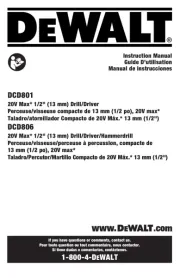
3 Augustus 2025
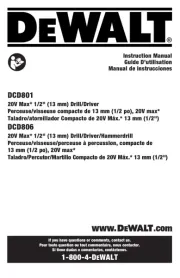
29 Juli 2025

4 Juli 2025
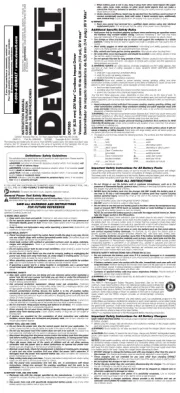
10 Juni 2025

2 Januari 2025

22 November 2024

15 November 2024

2 November 2024

23 September 2024

11 September 2024
Handleiding Boormachine
- Tacklife
- Rothenberger
- Global
- Kraftronic
- Clas Ohlson
- Panasonic
- RUKO
- Dexter
- Go On
- MSW
- Hilti
- Dedra
- Max
- McKenzie
- Alpha Tools
Nieuwste handleidingen voor Boormachine
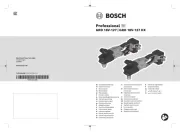
16 September 2025
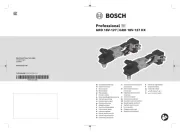
16 September 2025
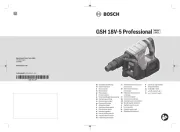
15 September 2025
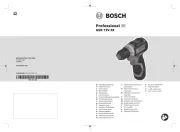
15 September 2025
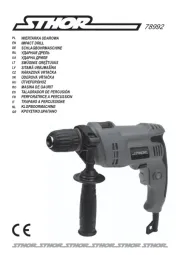
13 September 2025
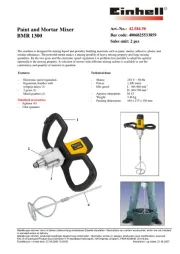
13 September 2025
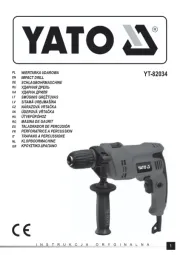
12 September 2025
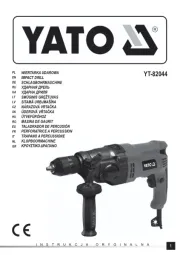
12 September 2025
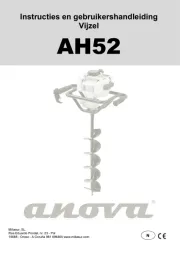
9 September 2025
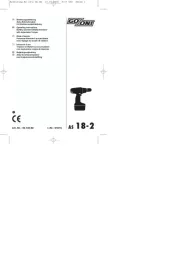
8 September 2025